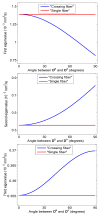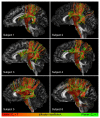The influence of complex white matter architecture on the mean diffusivity in diffusion tensor MRI of the human brain
- PMID: 22005591
- PMCID: PMC7613439
- DOI: 10.1016/j.neuroimage.2011.09.086
The influence of complex white matter architecture on the mean diffusivity in diffusion tensor MRI of the human brain
Abstract
In diffusion tensor magnetic resonance imaging (DT-MRI), limitations concerning complex fiber architecture (when an image voxel contains fiber populations with more than one dominant orientation) are well-known. Fractional anisotropy (FA) values are lower in such areas because of a lower directionality of diffusion on the voxel-scale, which makes the interpretation of FA less straightforward. Moreover, the interpretation of the axial and radial diffusivities is far from trivial when there is more than one dominant fiber orientation within a voxel. In this work, using (i) theoretical considerations, (ii) simulations, and (iii) experimental data, it is demonstrated that the mean diffusivity (or the trace of the diffusion tensor) is lower in complex white matter configurations, compared with tissue where there is a single dominant fiber orientation within the voxel. We show that the magnitude of this reduction depends on various factors, including configurational and microstructural properties (e.g., the relative contributions of different fiber populations) and acquisition settings (e.g., the b-value). These results increase our understanding of the quantitative metrics obtained from DT-MRI and, in particular, the effect of the microstructural architecture on the mean diffusivity. More importantly, they reinforce the growing awareness that differences in DT-MRI metrics need to be interpreted cautiously.
Copyright © 2011. Published by Elsevier Inc.
Figures









References
-
- Alexander AL, Hasan KM, Lazar M, Tsuruda JS, Parker DL. Analysis of partial volume effects in Diffusion-Tensor MRI. Magnetic Resonance in Medicine. 2001;45(5):770–780. - PubMed
-
- Alexander DC, Barker GJ, Arridge SR. Detection and modeling of non-Gaussian apparent diffusion coefficient profiles in human brain data. Magnetic Resonance in Medicine. 2002;48(2):331–340. - PubMed
-
- Ashburner J, Friston KJ. Unified segmentation. NeuroImage. 2005;26(3):839–851. - PubMed
-
- Assaf Y, Ben-Bashat D, Chapman J, Peled S, Biton I, Kafri M, Segev Y, Hendler T, Korczyn A, Graif M, Cohen Y. High b-value q-space analyzed diffusion-weighted MRI: Application to multiple sclerosis. Magn Reson Med. 2002;47(1):115–126. - PubMed
-
- Basser PJ. Relationships between diffusion tensor and q-space MRI. Magnetic Resonance in Medicine. 2002;47(2):392–397. - PubMed
Publication types
MeSH terms
Grants and funding
LinkOut - more resources
Full Text Sources
Other Literature Sources

